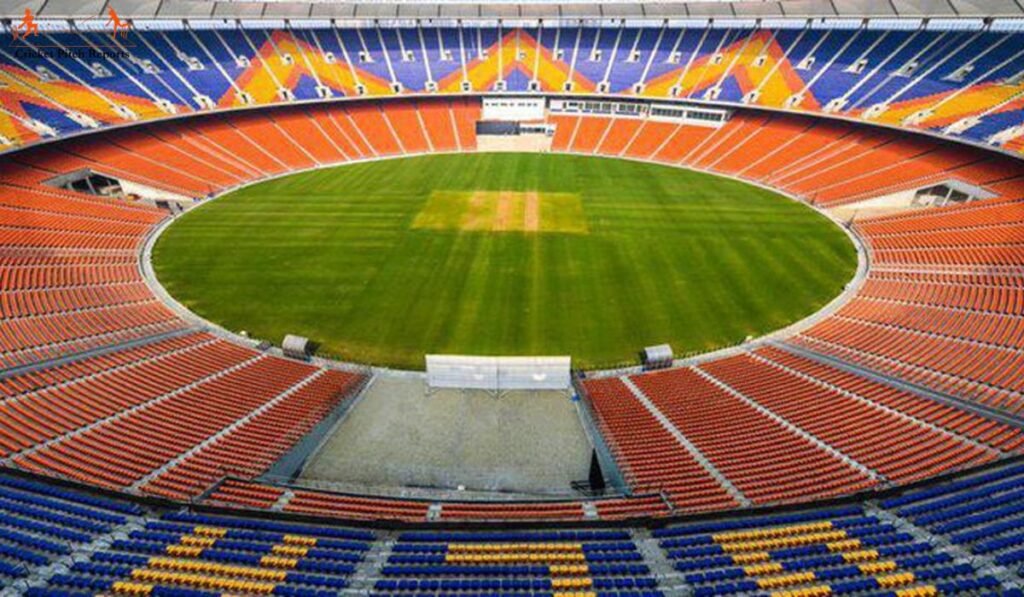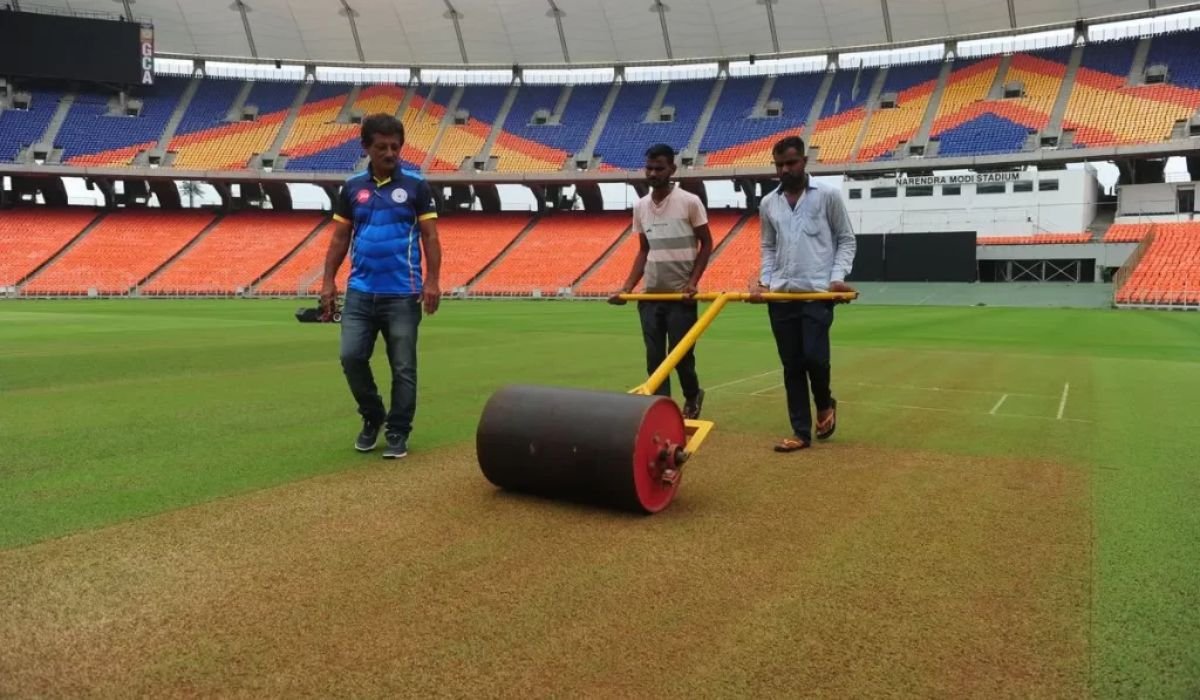Narendra Modi Stadium Pitch Report: The Narendra Modi Stadium in Ahmedabad is not just the largest cricket stadium in the world; however, it is also a multi-faceted environment where playing conditions have the potential to sway a match dramatically. With a gargantuan capacity of over 132,000, large, booming crowds will have any neutral spectator feeling nostalgic about the world’s greatest crowds that bring its atmosphere to life during big games. Previously named the Sardar Patel Stadium, previously the Gujarat Stadium, this stadium has been the setting for some of India’s greatest cricketing moments.
This ground is unique not for its size, but for its pitch design that boasts two-soil types-six red-soil pitches that will provide decent bounce and carry, and five black-soil pitches that conducive to slower, and more spin friendly surfaces. This means that the groundsman’s work will provide the rare opportunity to prepare surfaces for different formats so that the same venue can host a run-fest, T20 slugfest, and a test match that favors spin next week.
In this article, we will take a format-wise look at the Narendra Modi Stadium, deep-diving into pitch behavior, match stats, and tactical teachings from this ground’s lengthy life in test, ODI and T20I formats of cricket.
Narendra Modi Stadium Overview
| Attribute | Detail |
| City | Ahmedabad, Gujarat |
| Country | India |
| Also Known As | Sardar Patel Stadium, Gujarat Stadium |
| First Test | 12 Nov 1983 |
| First ODI | 05 Oct 1984 |
| First T20I | 28 Dec 2012 |
| Capacity | 132,000 |
| Soil Types | Red soil (bouncier) & Black soil (slower, spin-friendly) |
| Number of Pitches | 11 total – 6 red soil, 5 black soil |
The renovations completed in 2021 resulted in not only increasing capacity but also enhancements to drainage, lighting, and broadcasting facilities that allowed the venue to host day-night Test matches and major ICC events without a hitch.
Narendra Modi Stadium Pitch Report
The Narendra Modi Stadium is one of a kind in the cricketing world because of its non-reliance on a singular type of wicket preparation. The dual-soil approach has offered curators a great deal of flexibility:
Red Soil Pitches – This type of pitch provides more bounce, more pace off the surface, and would be more rewarding to stroke makers but offers carry and seam movement for fast bowlers in the first few overs of play. Generally, these pitches dry out much quicker because they lose moisture quickly and are slowly starting to deteriorate due to heat by Day 3, providing assistance to spinners in the longer format of the game.
Black Soil Pitches – Denser and slower in pace off the bat, they tend to have lower bounce from the outset. Generally, spinners can find their footing earlier due to the surface gripping the ball so readily. Additionally, black soil pitches retain moisture for a little bit longer, and therefore are trickier for batters to settle into their innings and be successful in the first session.
The outfield is lightning fast, so once a batter pierces the infield the runs start to flow easily. Respectively, the ground has boundary size variability – with straight boundaries measuring long and square boundaries measuring shorter. Active batsmen can now target horizontal-bat shots like cuts and pulls, rather than just looking to drive and cut the ball up the ground or square stand.
The stadium shape and size also affect play differently: In the afternoon, the wind can assist swing bowlers. When the temperature drops under lights, dew is a big consideration, particularly in limited-overs formats, it is particularly evident in that dew affects how effectively a bowler can grip a cricket ball.
Narendra Modi Statdium All Test Matches Record
- Total Matches Played: 15
- Matches Won Batting First: 4
- Matches Won Bowling First: 4
Average Scores Across Innings:
- 1st Innings: 347
- 2nd Innings: 353
- 3rd Innings: 232
- 4th Innings: 147
Notable Records:
- Highest Total Recorded: 760/7 (202.4 overs) by Sri Lanka vs India
- Lowest Total Recorded: 76/10 (20 overs) by India vs South Africa
- Highest Successful Chase: 80/1 (15.3 overs) by India vs England
Lowest Score Defended: 105/10 (38.5 overs) by South Africa vs India
| Match Date | Team 1 | Team 2 | Margin | Winner |
|---|---|---|---|---|
| Oct 2-6, 2025 | India | West Indies | – | – |
| Mar 9-13, 2023 | India | Australia | – | drawn |
| Mar 4-6, 2021 | India | England | inns & 25 runs | India |
| Feb 24-25, 2021 | India | England | 10 wickets | India |
| Nov 15-19, 2012 | India | England | 9 wickets | India |
| Nov 4-8, 2010 | India | New Zealand | – | drawn |
| Nov 16-20, 2009 | India | Sri Lanka | – | drawn |
| Apr 3-5, 2008 | India | South Africa | inns & 90 runs | South Africa |
| Dec 18-22, 2005 | India | Sri Lanka | 259 runs | India |
| Oct 8-12, 2003 | India | New Zealand | – | drawn |
| Dec 11-15, 2001 | India | England | – | drawn |
| Oct 29-Nov 2, 1999 | India | New Zealand | – | drawn |
| Nov 20-23, 1996 | India | South Africa | 64 runs | India |
| Feb 8-12, 1994 | India | Sri Lanka | inns & 17 runs | India |
| Mar 4-9, 1987 | India | Pakistan | – | drawn |
| Nov 12-16, 1983 | India | West Indies | 138 runs | West Indies |
India vs West Indies 1st Test Match: Ahmedabad Weather Forecast
Ahmedabad has experienced intermittent rainfall over the past few days, and the India Meteorological Department (IMD) has forecast the likelihood of light showers continuing in the coming days.

India Playing11 for 1st Test Match Against West Indies
Yashasvi Jaiswal, KL Rahul, Shubman Gill (c), Dhruv Jurel (wk), Ravindra Jadeja, Sai Sudharsan, Kuldeep YadavWashington Sundar, Nitish Kumar Reddy, Mohammed Siraj, Jasprit Bumrah
West Indies Playing11 for 1st Test Match Against India
Tagenarine Chanderpaul, John Campbell, Alick Athanaze, Roston Chase (c), Brandon King, Shai Hope (wk), Justin Greaves, Jomel Warrican, Johann Layne, Jayden Seales, Khary Pierre
How the Pitch Develops by Format and During the Game
- The Narendra Modi Stadium surface does not remain; it has distinct phases, and these developments greatly influence the game strategy.
In Test Matches
- Day 1 – 2: Red soil gives bounce and seam/black soil is already assisting spin; batting is possible if you see off the new ball.
- Day 3 – 4: Black soil pitches are beginning to break up, providing sharp-turn, and variable bounce; red soil pitches are beginning to crack providing reverse swing, and more spin than on days 1-2.
- Day 5: Batting is an exercise in survival as chasing anything over 150 can be very difficult.
In ODIs
- First 10 Overs: Early seam movement and swing for the pacers; the ball comes on to the bat if dry.
- Middle Overs: Pitch slows down somewhat, providing some aid to spinners; the pitch is playing true, so shot-making is still possible.
- Under Lights: Spinners sometimes turn to dew that flattens the surface and allows for the chasing side not to have the spin on to make it harder. Most teams will look to bowl first in day-night games in Australia.
In T20Is
- First Innings: Always good and flat with true bounce for the power hitters. The red soil tracks are more favourable for aggression and consistent scoring.
- Second Innings: Dew turns it into a batting surface. The spinners trouble the bowler with inconsistent grip, balls holding up and slower balls becoming ineffective.
There are always exceptions, and so, on occasion, if T20Is are played on black soil pitches, spinners may have some grip and turn available during the powerplay, although this is rare.
Narendra Modi Stadium Pitch Report: Pitch Behaviour in Tests
The red-soil pitches will start with more pace and bounce – so vast for fast bowlers on Day 1 and Day 2. However, once batters have got past the new ball, they can score big.
The black-soil pitches will start slow and become spin-friendly early. By the end of Day 2, these pitches will start keeping low, and by Day 3, the rough outside off-stump will be a good friend for a spinner.
By Days 4-5, even the red-soil pitches would have deteriorated to variable bounce and viscous turn. The fact that the highest successful run-chase is only 80 is indicative of how hard it is to bat last here.
Key Trends & Records
- Almost half the matches are draws, suggesting that not all surfaces deteriorate at the same rate.
- Kapil Dev’s 9/83 in 1983 is still considered to be one of the great fast-bowling spells in Indian conditions.
- Axar Patel’s 11/70 in 2021 vs England in a pink-ball Test was a sample of how much danger to visiting batters that (against unfamiliar Indian spin conditions) surface can offer.
- Mahela Jayawardene’s 275 in 2009 is a great representation of a normal, first-class cricketer, being able to score extreme runs if the batter can impose themselves in the early part of an innings.
Narendra Modi Stadium Pitch Report: ODI Pitch behaviour
ODI pitches at this ground generally provide a fairly even contest between bat and ball. Seamers can typically find some movement early, within the range of 5-7 overs, particularly when overcast or during cooler weather conditions. Once the ball has lost its shine, conditions generally favour the batter.
In day-night games, dew has a huge impact on the bat and ball duel. Chasing becomes more free-flowing when the ball skids onto the bat and spinning is often particularly affected because the ball loses grip. This is why captains will choose to bowl first in d/n games even if the surface looks to be dry.
Key Trends & Records
- The even win ratio of teams batting first, versus teams batting second (50% each way) indicates that pitch conditions appear to be balanced – think weather and dew, however for a larger effect than pitch bias.
- South Africa’s 365/2 in 2010 demonstrated the surfaces true potential as a batting surface when conditions are kind.
- Prasidh Krishna’s 4/12 shows that if seamers hit the right length early they can still dominate.
Narendra Modi Stadium Pitch Report: Pitch Behaviour in T20Is
Generally, the Narendra Modi Stadium is a batting paradise in T20Is. Even bounce, rapid outfield and relatively short square boundaries allow teams to consistently target scores of above 170.
The dew factor works against bowlers at night. The change in the pitch can create a dilemma for bowlers who often lose control of line and length, and although slower balls typically grip, the grip doesn’t remain as a consequence of dew, thus making slow balls easier to hit.
Key Trends & Records
- The average first-innings score of 183 is a telling indicator of just how good this surface is for stroke play.
- India’s dominance is also notable, with their players, Gill and Pandya, owning venue records.
- Lastly, the venue has the capacity to have extreme results – a perfect example would be New Zealand’s collapse for 66 in 2023, where bowlers on both teams are able to exploit early movement and grip.
Toss and Match Strategy Summary
| Format | Toss Importance | Preferred Decision | Key Influencer |
| Test | Moderate | Bat first | Spin from Day 3 |
| ODI | High | Bowl first (D/N) | Dew factor |
| T20I | Very High | Bowl first | Dew, short boundaries |
Pitch Behavior Comparison in Formats
Tests: The long format provided the pitch time to display all its moods: early bounce, late spin; black soil provided extra spin from the outset.
ODIs: Balanced surface with the toss heavily influenced by dew.
T20Is: High-scoring conditions with aggressive batting options; with the dew and small boundaries, defending totals was difficult.
Historical Games and Individual Significant Displays
- 1983: Kapil Dev’s 9/83: A fast-bowling masterclass that unsettled the West Indies.
- 2009: Sri Lanka’s 760/7 dec: Mahela Jayawardene’s 275, which resulted in one of the highest totals in Test history.
- 2010: South Africa’s 365/2 in ODIs: Kallis and AB de Villiers made batting look incredibly easy.
- 2021: Axar Patel 11/70; England’s batting capitulated under lights in a pink-ball test.
- 2023: Gill’s 126 in T20Is; a whole lot of pure hitting that summed up the ground’s T20 offering.
Conclusion
Narendra Modi Stadium is a chameleon across the formats of cricket; the identity will depend on pitch selection, conditions and formats for the matches.
In Tests, teams need to ready themselves for slow turners and a grind as surfaces wear down.
In ODIs, a team must be adaptable in managing early movement and late dew.
In T20Is, bowlers must have a clear strategy to combat flat batting surfaces and slippery conditions under lights.
This pitch values skill, yes – but more than anything, it values adaptability and tactical awareness.
Check More Stadiums Pitch Report:


